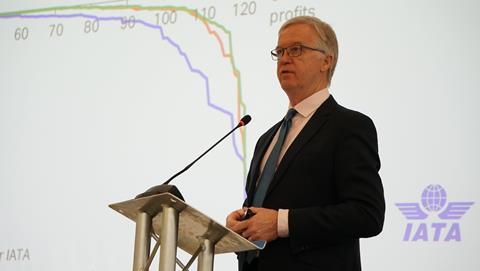Airlines will struggle to cut unit costs sufficiently to prevent cash burn continuing throughout 2021, based on current demand assumptions and in the absence of further government support, according to IATA.
“Airlines are still going to be burning through cash and making significant losses next year,” states IATA chief economist Brian Pearce during a briefing today, despite the sector’s efforts to right-size for much lower demand levels.
He suggests that further government financial support is likely to be needed, “if we are going to avoid a significant number of airline failures over the next 12 months”.
A universal pre-flight coronavirus testing regime would also help to improve airlines’ fortunes, Pearce believes.
Highlighting projections that airlines will achieve total revenues some 51% below pre-Covid forecasts in 2021 amid weak yields and depressed load factors, Pearce notes carriers would need to secure an “unprecedented” 30% fall in unit costs next year to break even.
“The industry just has to get smaller, at least for the next 12-18 months… and there must be some way of doing that without completely draining airlines of their cash reserves,” he says.
Labour costs are the “only sizeable option to cut costs sufficiently”, he states, but warns that even then, airlines are unlikely to become cash-positive.
Explaining the calculations, Pearce states that unit labour costs – measured in ASKs – would need to be 52% lower than those achieved in the second quarter of 2020 for airlines to match the lowest level of unit labour cost seen in the industry over the past five years.
Pearce states that airline job cuts have tended to be around the 30-35% level so far, although he adds that salary reductions also play a part.

Even reaching that challenging 52% reduction, however, would mean “break-even is not achieved” in 2021, Pearce explains, with other unavoidable costs such as those relating to fuel, aircraft and landing charges being relatively stubborn.
Indeed, IATA’s other assumptions are that fuel costs will tick up slightly next year, adding to the unit cost burden, while minor reductions in MRO, landing and other charges will only make a small difference to unit costs.
In terms of fleets, the switch to more short-haul flying is not necessarily favourable to unit costs, Pearce continues, as airlines need more aircraft to achieve the ASKs they would when long-haul, widebody services were more prevalent.
He points to data showing that while ASKs were some 62% lower in September this year, the in-service fleet was only 21% smaller.
Pearce also states that efforts to downsize fleets will help costs to a limited extent, as will small reductions in lease rates.
There are also upside risks to costs such as airport and ANSP charges, Pearce warns.


























